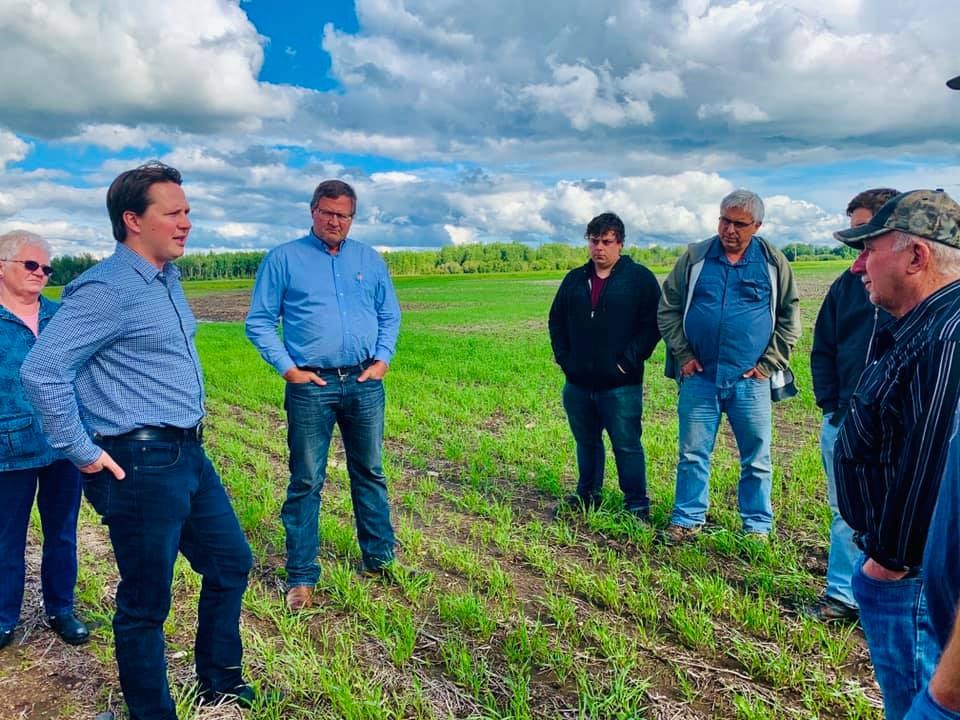ATHABASCA – Alberta's Minister of Agriculture and Forestry was provided a tour of the condition of some of the farmland in Athabasca County last week that led to the declaration of agricultural disaster in the county in June.
After declaring the disaster June 9, Athabasca County councillors Penny Stewart, Doris Splane and Travais Johnson met with ag minister Devin Dreeshen and Athabasca-Barrhead-Westlock MLA Glenn van Dijken near Grassland July 2, so they could see for themselves the damage that has been done and to meet with several area farmers to hear their concerns.
“We toured some roads and we basically let them see some of our poor crops in our county and all the unseeded acres, and we met with a few producers in a field. We had a little huddle in order to talk to the minister,” Stewart said.
Stewart added it is important for the minister to have boots on the ground to see the damages for himself and hear the issues farmers are having.
“It's bad. If it's one year it's one thing, but when it's four years, it's another. We're gonna lose some of our producers this year I'm sure. I really think it was so important that the ag minister just came out to see what was actually going on,” Stewart said.
Joseph Jenkins farms with his three brothers, one sister and father and he said they found out that day they would have a chance to speak to Dreeshen and van Dijken so he sat down with his wife and quickly thought up some questions.
“The biggest thing that I brought up was surrounding AFSC (Agriculture Financial Services Corp.) and crop insurance and some of their loan programs and stuff, and how AFSC needs to be changed a little bit. Farming is evolving and they are not keeping up with the changes quite as fast,” he said.
Jenkins added he talked about the challenges like crops left in the field from the fall, the early frost they had the year before, an early snowfall and all the challenges the weather has brought to their grain operation.
“I'd like to see insurance more on a field by field basis. So, if you had a quarter section drowned out, they would come out and adjusted it. You can till it under (and) write the crop off and then it takes that burden off the farmer having to try to do something with that field in the fall and you can try to get it in shape for the next seeding year,” Jenkins said.
He pointed out hail insurance is by the field, so questioned why crop insurance could not be the same way adding that in North Dakota it is field by field so can be done.
The second part of changing crop insurance is about the average production, Jenkins explained. For example, if a farmer’s average is 100 bushels per acre, they are insured for 80 bushels, so if the crop yield is 60 bushels, they get topped up to 80. Which is okay for established farmers, but new farmers have to go by a national average which can be very low.
"New farmers don’t have that average so they are based on a national average which is typically too low to provide them with the income they need to keep afloat,” he said.
And if yields are going down each year due to the heavy rains and early winters preventing full harvest, so too does the insurance. A farmer producing 100 bushels six years ago may have averaged 80 bushels for the last five years, meaning he is now insured for 64.
"When you're hit with these unexpected weather patterns and things like that it adds that extra challenge to it and it can equate to the crop failures. When your averages are hurt over the last five years that hurts everything. Your averages come down so then you're insured less. You can't borrow as much,” said Jenkins.
As a second-generation farmer Jenkins and his siblings can go off their father’s established averages, but because insurance is not field by field Jenkins will not get paid out on his land that drowned out.
Wet years also mean more costs on less crop. Jenkins said they had to rent equipment to repair a field with big ruts. Drying more grain also brings the electric bill up. It means Jenkins and his sister have to keep working off the farm to help supplement their investment. He added his brothers will pick up work in the winter.
“I work at Fort McMurray, so I feel like I get hit twice as hard because we’re getting hit up there,” he said.
Jenkins said he hoped Dreesen and van Dijken heard their concerns even though they did not provide any answers.
“They wouldn't give us a clear response. It was, ‘There's a bunch of options on the table and we're going to be putting a bunch of things forward to see what we can do to you bring in a reform to help kind of evolve as farming evolves and that kind of thing,” he said.
“And I asked (Dreeshen) if can we expect anything now and the answer he gave was ‘You got to look at it as a big ship and it's hard to turn and takes a long time. We’ve got lots of avenues and lots of bureaucracy to go through.’”
Heather Stocking, TownandCountryToday.com
Follow me on Twitter @HLSox

